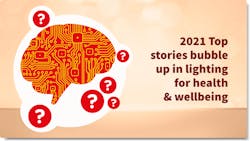Due to the phenomenon of time compression during the holiday season (anyone have proof of this?), I’ve rearranged the order of our top lists in “hot topics” to get this into the monthly Lighting for Health & Wellbeing newsletter today, and UV will be shared separately. I am sure that you can imagine UV was still fairly popular with our readers in 2021 — although many have wondered whether that interest would wane over time as pandemic conditions changed. So I do have thoughts to share on that, but they will come later this week for those who are not on holiday!
I continue to be energized by the potential of light and LED-based solid-state lighting (SSL) permeating applications beyond the illumination of space for visual acuity. Having said that, I am fully aware that there is not yet a consensus on industry best practices or wholehearted acceptance of circadian-related metrics. Industry viewpoints on the viability and proper implementation of antimicrobial light outside of the UV range from “it’s the only safe solution” to “it’s one tool in the box.” (Our contributors will get deeper into that in 2022.) The science of non-visual impacts of light is still evolving. The knowledge base continues to grow. And we will continue to learn about it alongside our readers.
1. Antimicrobial visible LED light is confirmed to deactivate viruses including SARS-CoV-2
As reported by chief editor Maury Wright in May, several laboratory trials documented that violet radiation around 405 nm can over time deactivate viruses, including the coronavirus that caused the COVID-19 pandemic. This was a significant piece of information missing from the antimicrobial light puzzle, as visible-light products had already been studied and determined to deactivate bacterial and fungal pathogens.
2. Violet-pumped Nichia LED offers quality light and germicidal benefits
At number 2 on our list, a technology launch story revealed that new LEDs from Nichia could deactivate bacterial pathogens while efficiently lighting a space. The dual-purpose packaged LED features a “strong 405-nm pump in the violet region” and a proprietary phosphor technology for uniformity of visible light. While Nichia claimed no viral deactivation with this announcement in January 2021, the cited research showed 1000 lx of radiation (due to the visible light) from nine LEDs at 40-cm distance deactivated more than 98% of the common bacterium Pseudomonas aeruginosa in five hours.
3. Subadditivity begins to explain the mysteries of the circadian system’s response to light
4. Creating the circadian lighting toolbox — Bringing the language into practice
The last two articles featured on our list are related — parts 3 and 4 from a technical series on circadian lighting written by Allison Thayer (formerly of the Lighting Research Center at Rensselaer Polytechnic Institute, now at the Light and Health Research Center, part of Mount Sinai’s Icahn School of Medicine). I do want to point out that the first two articles in the series were published in late 2020, so they would not appear as part of this 2021 compilation. But I strongly encourage everyone to follow the links in the articles to read all four parts as an in-depth introduction to circadian science, how non-visual receptors in the eyes and brain interpret light, and where to begin with correlating new terms and circadian concepts to application in the built environment.
I look forward to what 2022 will bring with regard to lighting beyond human visual needs. And for a look at what may come, I suggest reading our recent Q&A article with Mariana Figueiro and Jennifer Brons of LHRC. Cheers!
CARRIE MEADOWS is associate editor of LEDs Magazine, with 20 years’ experience in business-to-business publishing across technology markets including solid-state technology manufacturing, fiberoptic communications, machine vision, lasers and photonics, and LEDs and lighting.
For up-to-the-minute LED and SSL updates, why not follow us on Twitter? You’ll find curated content and commentary, as well as information on industry events, webcasts, and surveys on our LinkedIn Company Page and our Facebook page.





